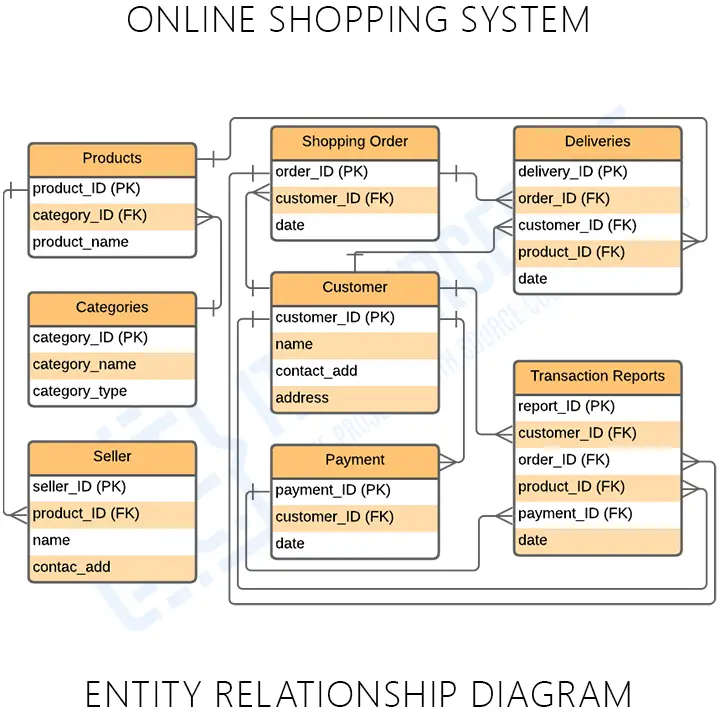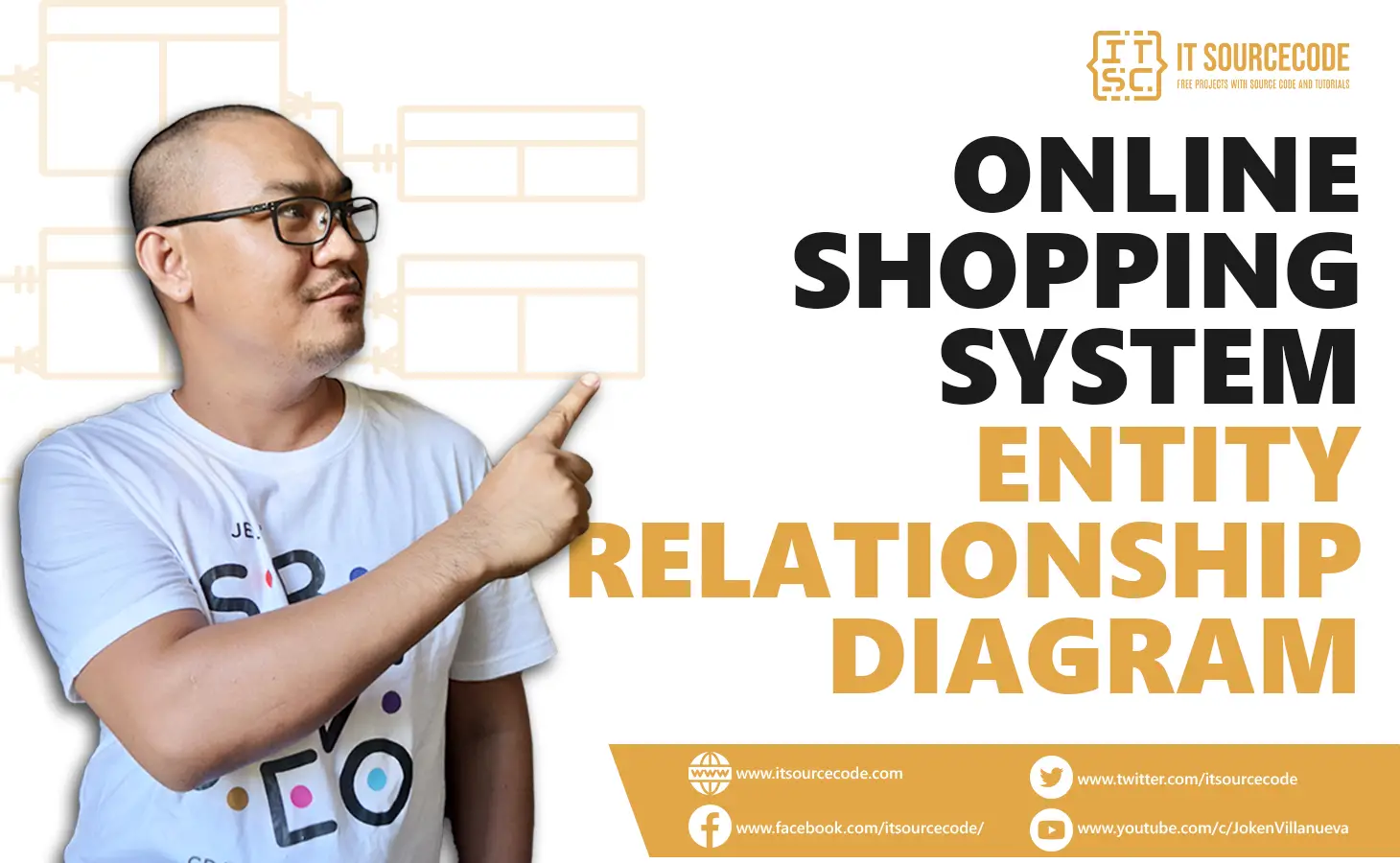The ER diagram for the online shopping management system shows the entities’ relationships to form the database design. It is also used to describe the logical structure of the system’s database or data storage. To create an ER diagram, you must know the system’s entities, attributes, and relationships.
Online shopping System ER Diagram: Details
The table shows the name and details of the online shopping system Entity Relationship Diagram. It also discusses the complete description of the project’s information.
| Name: | Online Shopping System ER Diagram |
| Abstract: | Online Shopping System ER Diagram depicts the relationship between various entities. It is also known as a blueprint for your system (project) structure. |
| Diagram: | ER Diagram is also known as Entity Relationship Diagram |
| Users: | Shopping App Admin, Online Sellers, and Shoppers. |
| Tools Used: | Diagraming tools that provide ER diagram symbols. |
| Designer: | ITSourceCode.com |
Implementation of Online Shopping System
An online shopping system is a type of electronic commerce that allows customers to buy goods or services over the Internet. It is done via a web browser or a mobile app.
Online Shopping Entity Relationship Diagram Features:
- Shopping Management: Saves the customers’ shopping information. It also serves as the admin’s basis for the order of the customer.
- Customer Management: This feature gathers important information about the customers. The gathered information was then used to determine the customer’s orders and transactions.
- Manage Transactions: This allows the admin to monitor the transactions made by the customers. It saves all the transactions done as well as the shopping information.
- Transactions and Reports Management: This feature stores the transactions made by customers. It also includes the information and reports of every transaction.
What is an ER Diagram?
The ER Diagram is referred to as the online shopping system’s database design. Both the ER diagram and the database design illustrate the relationships between all the system’s entities. Its major components are entities, attributes, and relationships.
Entity Relationship Diagram for Online Shopping System
The ER Diagram of Online Shopping shows the entity relationships in each entity and their supposed functions in each relationship.

Based on the image above, the Entity Relationship Diagram for the online shopping system is presented in tables. The tables include products, categories, sellers, customers, shopping orders, payments, deliveries, and transaction reports.
Online Shopping System Database Design
The database for the online shopping system was made based on how online shopping is managed. So, when a shopper buys something or puts in an order, the system should store information about them.
Online Shopping System ER Diagram Tables
The tables below provide the complete details such as field names, descriptions, data types, and character lengths. These tables represent the characteristics and attributes of data storage.
The field column lists each database’s attributes, while the description, type, and length columns describe each attribute’s purpose and data type.
Table Name: Customer
| Field | Description | Type | Length |
| customer_ID (PK) | Customer ID | Int | 11 |
| name | Customer Name | Varchar | 255 |
| contact_add | Customer Contact | Int | 11 |
| address | Customer Address | Text |
Table Name: Categories
| Field | Description | Type | Length |
| category_ID (PK) | Category ID | Int | 11 |
| category_name | Category Name | Varchar | 255 |
| category_type | Category Type | Varchar | 255 |
Table Name: Shopping Order
| Field | Description | Type | Length |
| order_ID (PK) | Order ID | Int | 11 |
| customer_ID (FK) | Customer ID | Int | 11 |
| date | Date of Order | Date |
Table Name: Deliveries
| Field | Description | Type | Length |
| acc_ID (PK) | Account ID | Int | 11 |
| customer_ID (FK) | Customer ID | Int | 11 |
| date | Date of Delivery | Date |
Table Name: Products
| Field | Description | Type | Length |
| product_ID (PK) | Product ID | Int | 11 |
| category_ID (FK) | Category ID | Int | 11 |
| product_name | Product Name | Varchar | 255 |
Table Name: Seller
| Field | Description | Type | Length |
| seller_ID (PK) | Seller ID | Int | 11 |
| product_ID (FK) | Product Name | Int | 11 |
| seller_name | Seller Name | Varchar | 255 |
Table Name: Payment
| Field | Description | Type | Length |
| payment_ID (PK) | Payment ID | Int | 11 |
| customer_ID (FK) | Customer ID | Int | 11 |
| date | Date of Payment | Date |
Table Name: Reports
| Field | Description | Type | Length |
| report_ID (PK) | Report ID | Int | 11 |
| customer_ID (FK) | Customer ID | Int | 11 |
| order_ID (FK) | Order Id | Int | 11 |
| product_ID (FK) | Product Id | Int | 11 |
| payment_Id (FK) | Payment Id | Int | 11 |
All in all, the tables are given to be the basis for developers on how they would design the online shopping system’s database. It has a complete description of the database. Then the developers will put this into the program.
Online Shopping System ER Diagram [PDF]
The Entity Relationship Diagram for Online Shopping System PDF explains the concepts of the project database. In fact, you may apply this information to your capstone project. You can also use it as is or change its content to fit the needs of your project.
How to create ER Diagram
Time needed: 5 minutes
Steps in building the ER Diagram for Online Shopping System with Cardinality Ratio.
- Step 1: Familiarize the Entity Relationship Diagram Symbols and Cardinality
First, you need to familiarize the needed symbols.
ER Diagram Symbols:
Fields: Fields are the parts of a table that define the entity’s characteristics. In the database that the ERD models, attributes are also known as rows.
•Keys is a technique to categorize data quality. It is used to organize ER diagrams and assist users in modeling their databases. This is also used to connect different tables in a database.
-Primary Key: identifies a single entity instance, which means a unique attribute or set of attributes.
-Foreign Key: is produced when data attributes have one too many relationships with other entities. - Step 2: Finalize the entities included
Second, design your ER Diagram by finalizing the entities that must be included in your online shopping system. This entity is represented by a rectangle.
- Step 3: Add the attributes of each entity
Next is to add the attributes to each entity. Think about the qualities you’ll need to characterize an entity. The details of the various entities outlined in a conceptual ER diagram are supplied as attributes.
- Step 4: Describe the relationships (cardinality) between entities and attributes
Finally, establish relationships between the entities. Specifically, one-to-one, one-to-many, and many-to-many are the three most common cardinal relationships. It’s the maximum number of times that one entity can be linked to another entity.
Conclusion:
In conclusion, the ER diagram is not only applied to online shopping database design but also the foundation of other diagrams. This diagram is modeled to specify not only the exact destination of data but also the source of data.
Related Articles:
- Loan Management System ER Diagram
- ER Diagram for Online Ordering System
- ER Diagram for Bank Management System
- ER Diagram for Hotel Management System
- ER Diagram for Student Management System
Inquiries
So, if you have inquiries or suggestions about the Entity Relationship Diagram for Online Shopping System, just leave us your comments below. We would be glad to know your concerns and suggestions and be part of your learning.
Keep us updated and Good day!


Wouldn’t there need to be another entity like “Order Details” between Product and Delivery to be able to have multiple products in an order?